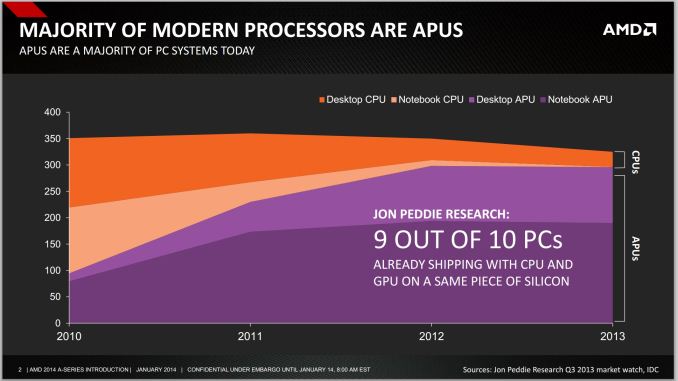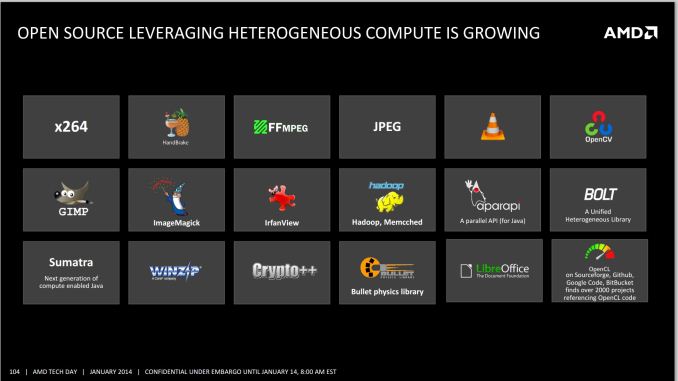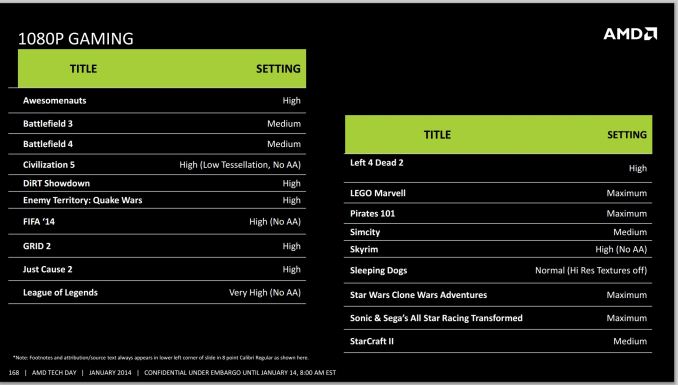AMD Kaveri Review: A8-7600 and A10-7850K Tested
by Ian Cutress & Rahul Garg on January 14, 2014 8:00 AM ESTKaveri: Aiming for 1080p30 and Compute
The numerical differences between Kaveri and Richland are easy enough to rattle off – later in the review we will be discussing these in depth – but at a high level AMD is aiming for a middle ground between the desktop model (CPU + discrete graphics) and Apple’s Mac Pro dream (offloading compute onto different discrete graphics cards) by doing the dream on a single processor. At AMD’s Kaveri tech day the following graph was thrown in front of journalists worldwide:
With Intel now on board, processor graphics is a big deal. You can argue whether or not AMD should continue to use the acronym APU instead of SoC, but the fact remains that it's tough to buy a CPU without an integrated GPU.
In the absence of vertical integration, software optimization always trails hardware availability. If you look at 2011 as the crossover year when APUs/SoCs took over the market, it's not much of a surprise that we haven't seen aggressive moves by software developers to truly leverage GPU compute. Part of the problem has been programming model, which AMD hopes to address with Kaveri and HSA. Kaveri enables a full heterogeneous unified memory architecture (hUMA), such that the integrated graphics topology can access the full breadth of memory that the CPU can, putting a 32GB enabled compute device into the hands of developers.
One of the complexities of compute is also time: getting the CPU and GPU to communicate to each other without HSA and hUMA requires an amount of overhead that is not trivial. For compute, this comes in the form of allowing the CPU and GPU to work on the same data set at the same time, effectively opening up all the compute to the same task without asynchronous calls to memory copies and expensive memory checks for coherency.
The issue AMD has with their HSA ecosystem is the need for developers to jump on board. The analogy oft cited is that on Day 1, iOS had very few apps, yet today has millions. Perhaps a small equivocation fallacy comes in here – Apple is able to manage their OS and system in its entirety, whereas AMD has to compete in the same space as non-HSA enabled products and lacks the control. Nevertheless, AMD is attempting to integrate programming tools for HSA (and OpenCL 2.0) as seamlessly as possible to all modern platforms via a HSA Instruction Layer (HSAIL). The goal is for programming languages like Java, C++ and C++ AMP, as well as common acceleration API libraries and toolkits to provide these features at little or no coding cost. This is something our resident compute guru Rahul will be looking at in further detail later on in the review.
On the gaming side, 30 FPS has been a goal for AMD’s integrated graphics solutions for a couple of generations now.
Arguably we could say that any game should be able to do 30 FPS if we turn down the settings far enough, but AMD has put at least one restriction on that: resolution. 1080p is a lofty goal to hold at 30 FPS with some of the more challenging titles of today. In our testing in this review, it was clear that users had a choice – start with a high resolution and turn the settings down, or keep the settings on medium-high and adjust the resolution. Games like BF4 and Crysis 3 are going to tax any graphics card, especially when additional DirectX 11 features come in to play (ambient occlusion, depth of field, global illumination, and bilateral filtering are some that AMD mention).













380 Comments
View All Comments
JDG1980 - Tuesday, January 14, 2014 - link
Steamroller offers about 10%-15% better IPC in integer benchmarks, and reduces the multi-threading penalty. The problem is that Kaveri has to run at a lower clock speed, because Global Foundries can't get their act together on 28nm. As a result, you've got 3.5 GHz Steamroller cores on Kaveri competing with 4.1 GHz Piledriver cores on Richland, and the IPC improvement isn't good enough to make up for that (especially on floating point).silverblue - Tuesday, January 14, 2014 - link
The other problem is, they streamlined the FPU to remove an MMX pipe, and... that's it. Still, it reduces power usage.Following AMD's own Opteron roadmap, Steamroller was meant for greater parallelism, nothing said of IPC - that's for Excavator. A new FPU, perhaps? I'd certainly like to see larger cores than currently, or a smarter way of dealing with the workloads in single threaded work on a modular basis.
mikato - Wednesday, January 15, 2014 - link
I'd be happy with even just 6 and 8 core Steamroller chips. FX is dormant for now? Nothing appealing to gamers at all. It seems like a race against the clock with HSA - that stuff is needed ASAP. Ok, if Excavator improves IPC (and hopefully they can increase the clock speed again) then it had better get here soon as well.iisdev - Tuesday, January 14, 2014 - link
Thanks for the detailed review.I was hoping that Skyrim would be included in the performance tests; Intel had used it specifically to demonstrate Haswell's IG capabilities and it would have been great for a comparison.
It doesn't sound like the A10-7850K would be capable of Skyrim on Maximum at 60fps.(either at 1080p or even 720p) Is that a correct analysis?
neogodless - Tuesday, January 14, 2014 - link
Is the A8-7600 identical to the A8-7600 except for the differences?A8-7600 2M/4T 3.3 GHz
3.8 GHz 2133 65W R7 384 720 MHz
A8-7600 2M/4T 3.1 GHz
3.3 GHz 2133 45W R7 384 720 MHz
nightbringer57 - Tuesday, January 14, 2014 - link
"Is the A8-7600 identical to the A8-7600 except for the differences?"I think this sentence is so aweome I'm gonna print it and read it aloud ten times a day before waking up :D
neogodless - Tuesday, January 14, 2014 - link
:) I hadn't read everything and later realized they just had different TDP configurations. Oops!Though later they say they "also took a few AMD processors of varying TDPs:" and then show a chart of Intel processors.
mikato - Wednesday, January 15, 2014 - link
I didn't realize Yogi Berra was into computers.Gadgety - Tuesday, January 14, 2014 - link
Excellent review. I particularly appreciate the comparison of the much more expensive Iris Pro, and the dGPU. Hope you incorporate an update with 2400 memory modules. That said I think I saw somewhere 65W version 7800 with the 512 GPU stream processors. Hopefully that one will be launched to enable a truly SFF family PC capable of some gaming.Krysto - Tuesday, January 14, 2014 - link
Any chance we could see Nvidia adopt HSA in the next 2 years? I think they're just being a pain in the butt. ARM competitors don't seem to have a problem with supporting HSA. What's Nvidia's deal? They seem to always be going for proprietary solutions instead of supporting a standard. They don't even support OpenCL in Tegra K1, but support CUDA 6.I think I even read an article about the history of OpenGL vs DirectX that said the OpenGL coalition started failing when Nvidia kept rolling their own proprietary extensions, and then it just gave Microsoft the opportunity they need it to take over with DirectX. I want to like Nvidia but they are making it so hard to like them.